
shapecharge/iStock via Getty Images
As the Fed’s decision on interest rates approaches, the S&P 500/SPX (SP500) and stocks, in general, are going through another volatile phase. However, it’s not just the FOMC meeting. Russia’s invasion of Ukraine, soaring energy prices, high and persistent inflation, and now a possible Russian default all contribute to the recent selling wave on Wall Street.
SPX 1-Year
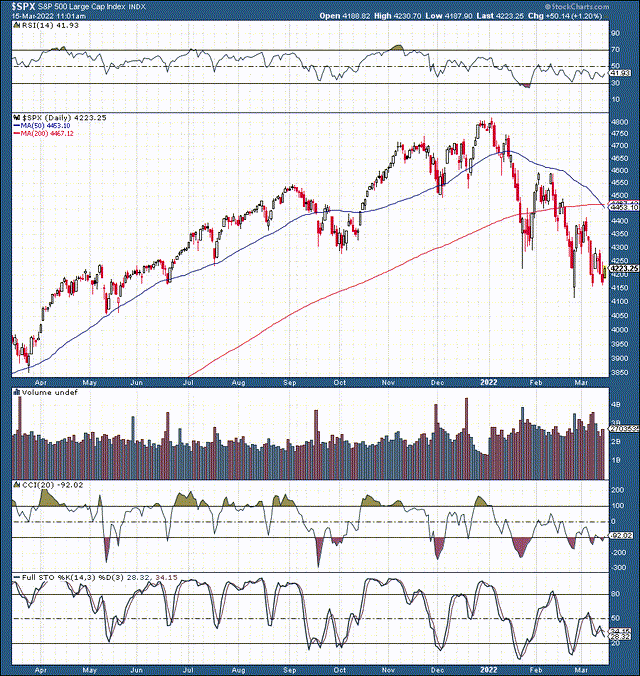
SPX (StockCharts.com)
The SPX has been trending lower since the year began and has given up about 15% from its ATH, making this one heck of a correction to kick off the new year. Moreover, the SPX is approaching a critical support level at 4,100. If this crucial support level breaks down, the major average could slide into the 4,000-3,800 range next, leading to a full-blown 20% correction. However, the fundamental concerns may be overexaggerated here, and the SPX is likely near an intermediate-term bottom right now. I recently added several badly beaten-down stocks, and I’m looking to buy more as the SPX should stabilize, recover, and proceed higher after the FOMC event.
The Fed: Not That Hawkish Anymore
There was a strong probability for a 50 basis point rate increase about a month ago, but that is no longer the case. With the Russia/Ukraine conflict, the rolling correction, questionable economic readings, and other elements, the Fed will probably take a less hawkish approach as we advance.
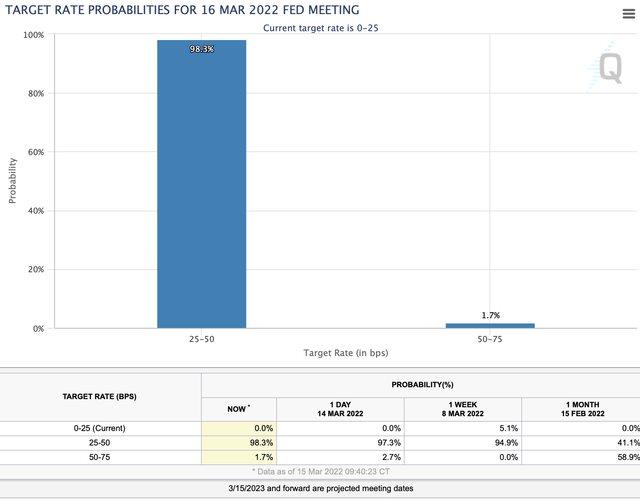
FOMC (CMEGroup.com)
We see that while there was about a 60% probability for a 50 basis point rate hike at the March meeting a month ago, the odds have dropped to less than 2% now. With stocks cascading lower in recent months and current geopolitical issues, the Fed will likely take a more dovish approach to normalize rates. We’ve seen a sharp pullback in aggressive rate hike expectations in recent weeks, and provided the current economic environment, this trend will likely persist for some time. I’ve sounded the caution alarm for weeks regarding the new phase of the 2022 correction, but we may finally see an end to this selloff if the Fed gives the market what it wants, a more dovish monetary approach.
The Jobs Report

Jobs report (Investing.com)
The most recent jobs/non-farm payrolls report was exciting. On the one hand, we saw highly robust jobs growth, especially in the private sector. This dynamic illustrates that the economy remains vibrant and is still expanding at a healthy pace. On the other hand, we saw the average hourly earnings rise by less than expected. The more minor than anticipated jump in hourly earnings implies that inflation may not be as raging hot as illustrated by other inflation gauges, and the Fed may take a more dovish approach in its path to “normalize” interest rates. In addition, the PPI and additional inflation and economic readings have been cooler than anticipated, further adding to the notion that the Fed should take a less hawkish approach in respect to tightening monetary conditions.
Not To Fear The Russian Default
There’s talk of a Russian default now, but these fears may be overblown. Yes, the Russian economy is crumbling, but the country has a remarkably low debt to GDP ratio. Russia’s national debt is only around 18% of GDP (2020), and the country’s roughly $700 million in March debt payments are not very significant. Therefore, Russia may not default on its debt as its debt payments are relatively small. Furthermore, Russia could plausibly receive economic help from the Chinese Communist Party (“CCP”), and even if the country defaults on some of its debt, it will likely have a limited contagion effect globally. According to the IMF’s managing director, global banks have about $120 billion exposure to Russia, which is not systemically important. I’m more concerned about Russian companies defaulting on their debt moving forward, but that too should have a relatively limited contagion effect, especially in the U.S.
The Best House In A Bad Neighborhood
While there are apparent issues with the U.S. economy and the U.S. stock market, it’s still likely the best house in a bad neighborhood. The world is a troubled place right now. We see high inflation, military conflicts, and many other issues. Europe is riskier than usual because of Russia’s rampage in Ukraine and the risk for a broader war on the continent. Russia also has a more significant impact in Europe due to the Union’s dependence on Russian energy resources. The U.S. doesn’t have such issues and is well insulated by vast oceans and a remarkably resilient economy. Therefore, money should keep flowing to the U.S. and continue to find itself in the U.S. stock market. Right now, the forward P/E ratio on the S&P 500 is only about 18.85, which is not high given the current economic and monetary dynamics. Therefore, if the growth story in the U.S. remains intact, and the Fed takes its foot off the hawkish gas peddle, we can probably see a substantial rally on multiple expansion as we advance through Q2 and into the second half of the year.
My Recent Adds
We’re starting to see some constructive price action in some of my favorite stocks. Moreover, many quality growth stocks have gotten stomped on in recent weeks and now represent compelling buying opportunities.
Advanced Micro Devices (AMD)
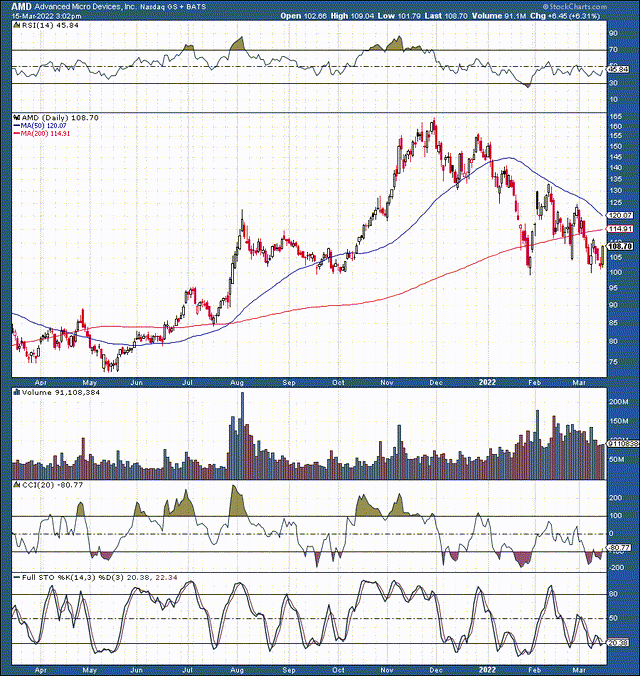
AMD (StockCharts.com)
AMD is one of the best companies around, in my view. AMD continuously surpasses consensus analysts’ estimates, expands rapidly, and becomes increasingly profitable. AMD is trading at about 25 forward EPS estimates, and the company could very well top estimated results. AMD’s technical image is improving, as the stock has held the $100 support level several times. AMD has a substantial probability of moving significantly higher through 2022, which is why I recently doubled down on my AMD position.
SoFi (SOFI)
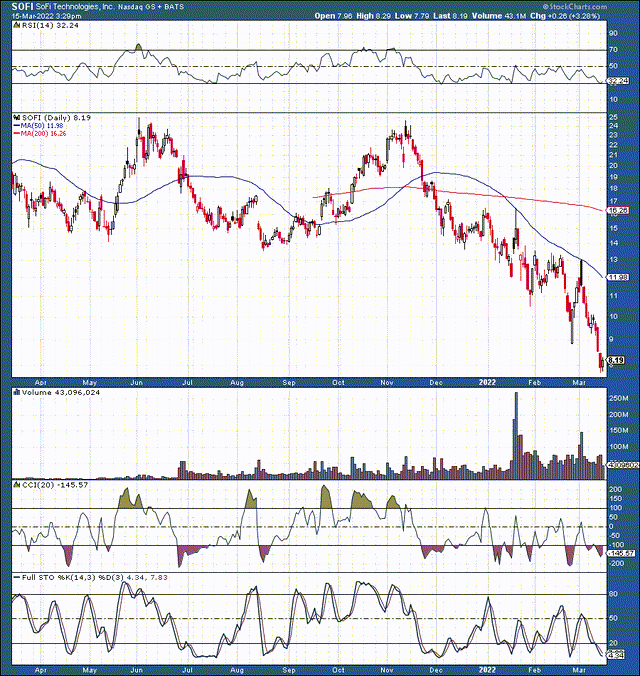
SOFI (StockCharts.com)
SoFi was flying high in November, but the stock has gotten hammered in recent months. We’ve seen a drop of nearly 70% from its ATH, and it looks like the selling may be overdone in SoFi. The company has a significant growth potential of more than 50% YoY revenue growth projected for next year. Yet, the stock is now trading at only about three times sales. This valuation is remarkably cheap for a rapidly expanding company with a substantial growth runway ahead. I recently went ahead and doubled my SoFi position below $10, and I expect this stock can move significantly higher over the next 1-2 years and longer term.
Palantir (PLTR)
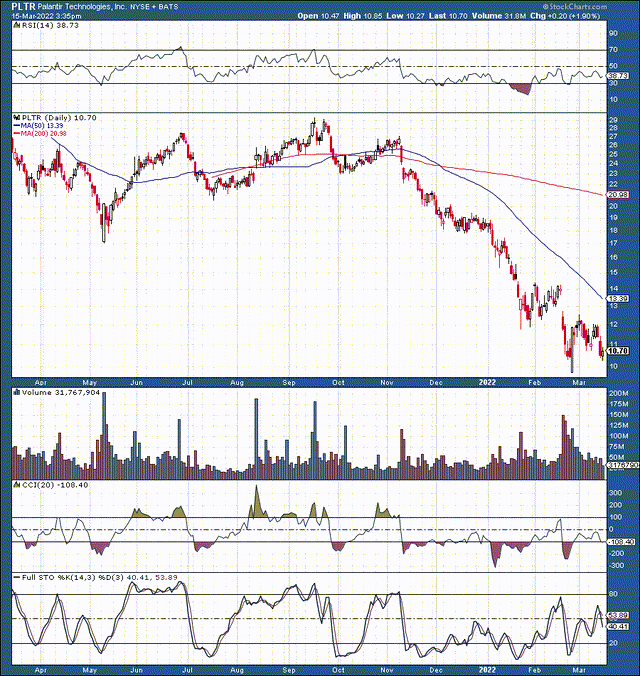
PLTR (StockCharts.com)
Palantir is another growth name that has had a very rough ride over several months. Its share price has also slumped by about 70% from its 52-week high. However, around $10 Palantir is a very compelling buying opportunity, in my view. The company has significant growth prospects and also has the potential to become remarkably profitable over time. Palantir gets criticized for its SBC and its dependence on government contracts. However, the company’s shares should move substantially higher as Palantir’s problems get alleviated in future years. Palantir is one of the most promising growth companies in the U.S., not a Chinese scam company.
Portfolio Allocation
I mentioned several companies, but I’m long quite a few names in the All-Weather Portfolio (“AWP) right now. The AWP’s diversified holdings are up by about 7% YTD, which is substantially higher than the 10% loss in the S&P 500 and the 17% decline in the Nasdaq Composite. An intermediate-term bottom could be close, and we may see a significant rally following the FOMC decision. It appears that the fundamental factors and an improving technical setup could propel stocks and other risk assets significantly higher from current oversold levels. In addition to our 62% asset allocation to stocks 26% allocation to gold, silver, and miners, I recently built up the AWP’s cryptocurrency basket to 10% of holdings as well. I suspect that risk assets can have a notable rally from here, provided that the Fed takes a more dovish stance on monetary policy.
from WordPress https://ift.tt/BF4RjJM
via IFTTT


No comments:
Post a Comment